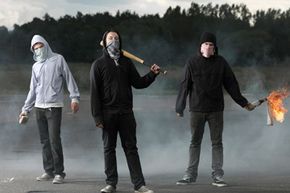Starting a Riot
A leader doesn't create a riot; rather, riots create leaders. That means you probably won't find someone who plotted the course of a riot for days in his basement, or hear someone order everyone else to start overturning cars. Riots lack organization and it's too risky for anyone to take charge of beginning the riot. Instead, intuition guides individual rioters, who then become captive to a mob mentality.
Let's say a riot trigger has occurred -- more importantly, let's say that this event took place on a sunny afternoon, as riots rarely occur in the morning or in bad weather [source: Heal]. Riots also tend to happen in urban areas as opposed to rural ones, and they're usually made up of younger people as opposed to older people [source: Heal]. Perhaps it's the urban setting that makes it easier for crowds of people to spontaneously gather in one place after a riot trigger, as there are landmarks and notable neighborhoods. In one study, people were asked where they would go to meet someone if they were unable to set a meeting place ahead of time; most people tend to pick out the same landmarks over and over, indicating that we might possess a certain ability to coordinate with people we've never met [source: Haddock, Polsby]. Of course, knowing where to join a riot in progress is much easier, as television news reports and social media can indicate where the action is.
Advertisement
As people begin to gather, they evaluate each other -- is this person on my side? Are there enough of us to outnumber a police force? Are there witnesses that would turn us in? If I throw a rock in a window, will these people join me? That last question is crucial, as it's foolish to risk arrest if no one will join you. But once there are enough people (subtly communicating their desire to wreak havoc), then someone will be brave enough to start the violence. Throwing a rock through a window is a preferred way of doing this, as it creates a sound that can be heard by many, even if it isn't seen [source: Haddock, Polsby].
It takes a certain amount of emotional intelligence for a person to be able to predict and read so many strangers' behavior. Once the violence begins, however, the individual becomes part of the group, and groups can make people do things they wouldn't normally do alone. We'll consider the psychology of mobs on the next page.
